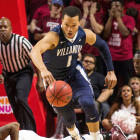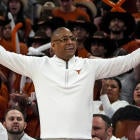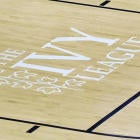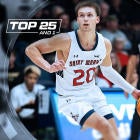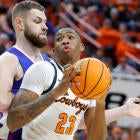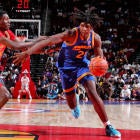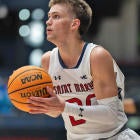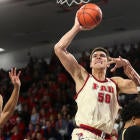The Big East is officially back.
On the heels of its first national title since realignment, this league is ready to move forward as one of the premier conferences in college basketball.
Check out below as we highlight five offseason storylines in the Big East.
1. Villanova is well equipped for a repeat
Jay Wright's squad may have lost two critical pieces in Ryan Arcidiacono and Daniel Ochefu, but the Wildcats still have everything in place to compete for another national title.
Villanova returns three starters in Jalen Brunson, Josh Hart and Kris Jenkins while also returning three key reserves in Phil Booth, Mikal Bridges, and Darryl Reynolds.
Wright also adds a four-star recruit in big man Omari Spellman as well as Fordham transfer Eric Paschall, a versatile 6-foot-7 combo forward who averaged 15.9 points and 5.9 rebounds two seasons ago. Donte DiVincenzo will also be counted upon as a critical perimeter reserve after red shirting last year as a freshman.
There's no way to predict how this team will handle life without Arcidiacono early, but this is still a program that has won a combined 97 games over the last three years.
Villanova has six players back from a team that beat Iowa, Miami, Kansas, Oklahoma, and North Carolina in succession last March while adding a top-flight freshman and an impact transfer.
The Big East still goes through the Main Line.
2. Edmond Sumner is Xavier's version of a volcano
And there's a good chance that he erupts next season.
The 6-5 point guard arrived on the Big East scene last year after red shirting during the 2014-15 campaign and immediately had a major hand in the Musketeers' 28-win season.
Armed with great size for a floor general, Sumner (11.0 points, 3.4 rebounds, 4.6 assists in 2015-16) can see over most opposing point guards and also possesses the athletic ability to finish at the rim with power and authority.
The real question now is whether or not he can become a consistent enough outside shooter to keep the defense honest after shooting just 30.1 percent from long distance as a freshman.
If that happens, Chris Mack could have one of the more lethal pick-and-pop combinations in college basketball with Sumner and junior forward Trevon Bluiett (15.1 points in 2015-16).
3. The Big East is more balanced than it's ever been
Villanova and Xavier both look like legitimate top-five teams from a national perspective and the rest of the Big East isn't chopped liver.
Creighton and Seton Hall will enter next season with NCAA aspirations while Georgetown is off-the-radar, but still capable following a sub .500 season a year ago.
That leaves St. John's, Butler, Marquette, Providence, and DePaul left to round out the conference's second half and all of those teams possess capable players who can put the ball in the basket.
After Villanova and Xavier, the next eight teams in the Big East are as close as they've ever been since the creation of this league prior to the 2013-14 season.
The bottom of this conference has officially caught up to the middle.
4. St. John's has a legitimate Big East roster
Chris Mullin's first season as head coach of his alma mater resulted in an 8-24 finish, but the reinforcements have finally arrived in Jamaica.
The Red Storm will add two potential All-Big East players in red shirt freshman Marcus LoVett and JUCO transfer Bashir Ahmed while also adding a pair of four-star recruits in Shamorie Ponds and Richard Freudenberg.
Federico Mussini, Malik Ellison, Kassoum Yakwe, and Yankuba Sima all return after averaging over 20.0 minutes last year in their first season of college basketball with Yakwe set to emerge as potentially the top intangible player in the Big East.
A freak athlete at 6-7, Yakwe had nine games last year with four or more blocks and possesses the type of athleticism and timing that make him an absolute menace to play against.
Mullin got St. John's to compete on a regular basis during his first season as head coach, but now comes the hard part: manufacturing wins when the talent base of your program is comparable to everyone else in the conference sans Villanova and Xavier.
It will be real interesting to see how St. John's handles the first few times that it's in a 60-60 game with four minutes to play.
5. Georgetown looks like a sleeper
Are the Hoyas the Big East's forgotten team?
It certainly feels that way.
Georgetown never recovered from a poor start last season and wound up finishing 15-18 despite wins over Wisconsin, Syracuse, and Xavier. The Hoyas' were a step slow on defense and had obvious issues defending teams who possessed multiple quick guards who could get into the paint.
John Thompson III has added three new pieces on the perimeter in JUCO transfer Jonathan Mulmore, grad transfer Rodney Pryor (Robert Morris), and freshman guard Jagan Mosley, but how will these new parts blend with the surplus of players that return?
Georgetown returns eight players -- yes, eight -- from last year's team that played double-figure minutes and that doesn't include Louisville transfer Akoy Agau or Paul White, who only played seven games in 2015-16 due to injury.
That means that all 13 of the Hoyas' scholarship players should enter next year with the mindset that they can be an active member of Georgetown's rotation.
Will Thompson extend his bench and play faster to get more players on the floor?
Will someone redshirt since there's so many capable bodies with minimal separation?
Those questions will be answered in the fall during what should be an extremely competitive preseason considering the amount of playing time that's currently up for grabs in the Hoyas' program.
Georgetown's potential 2016-17 rotation may look like a bit of rubik's cube right now, but here's something that can't be denied: this team has three legitimate All-Big East players in L.J. Peak (12.3 points, 3.3 rebounds in 2015-16), Isaac Copeland (11.1 points, 5.4 rebounds in 15-16) and Marcus Derrickson (7.1 points, 4.5 rebounds in 15-16).
If the Hoyas' supporting cast can sort itself out then Georgetown has more than enough capable pieces to emerge as the third best team in the Big East next season.
This and That
- Seton Hall isn't the team it would have been if Isaiah Whitehead opted to return to school, but the Pirates still return four players -- Angel Delgado, Khadeen Carrington, Desi Rodriguez, and Ismael Sanogo -- who logged over 800 minutes last year. Kevin Willard should have this team in the mix for an NCAA bid for the second consecutive season.
- Creighton's Greg McDermott told CBS Sports that Kansas State transfer Marcus Foster is down to eight percent body fat. He was at 14.0 percent when he arrived in Omaha last summer. The 6-3 guard averaged 14.0 points during two years with the Wildcats before transferring and is an All-Big East first-team caliber player if he's performing up to his capabilities.
- How will Xavier replace both James Farr and Jalen Reynolds up front? The early money is on Norfolk State transfer RaShid Gaston. The 6-9, 240-pound big man averaged 15.5 points and 9.6 rebounds two years ago and should step right in for the Musketeers in the middle.
- Ed Cooley has done an unbelievable job making Providence's program relevant from a national perspective over the last few years, but no team in the Big East lost more than the Friars. After three consecutive appearances in the NCAA Tournament, it's awfully tough to see Providence playing in the field of 68 after losing both Kris Dunn and Ben Bentil.
- The under-the-radar newcomer to the Big East next season is Marquette's Andrew Rowsey. A transfer from UNC-Asheville, the 5-10 Rowsey made a combined 206 3-point shots during the first two years of his college career while averaging 19.8 points during that span.
- Is Georgetown considering playing at a faster pace next season? Find out the answer to that question and others in this week's College Hoops Today Podcast.












